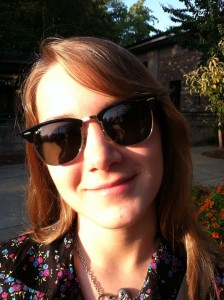By Lois Carlisle
The most mysterious thing about my mother was her white recipe binder. She would send me to pluck it from the baker’s rack when I was a little kid. She spilled past me in the front room after she returned from work at Mary’s, a catering company in town. I grabbed the binder and followed her to the kitchen. I felt like the member of a church procession who held the Bible on Sundays. These pages contained holy writ.
“What’s for supper?” I asked as I delivered the volume into her hands.
“Let’s see,” she said. With her free hand, she hooked me under the arm and hitched me up onto her hip. My mother was strong. Her arms were toned from beating egg whites and crating sacks of flour around the kitchens at work. “What about chicken and dumplings?” She dropped her binder onto the counter. Like always, it fell open to the page that she wanted. She sat me next to the book.
Watching my mother cook was watching her dance. Stove to cabinet to sink to fridge. Always placing things in the oven, she closed the hot door with her her hip. My mother never turned on the oven light unless I wanted to watch something bake. She tossed ingredients into bowls and whisked them until they were fluffy. She threw open pantry doors and fished out what she needed without a trace of hesitation. My mother moved through the kitchen as naturally as she breathed.
I remember how thrilled Mom was to have her own stand mixer. Dad bought her a white Cuisineart one Christmas. She used it compulsively. If ingredients needed to be combined, they went in that new metal bowl. She was always trying new things: chilled vegetable pizza, lemon-basil chicken, herbs-stuffed zucchini, aubergine polenta. To me, this production was magical. How someone could place flour and water in a bowl, then turn it into biscuits was unknowable. Mom worked in food service all her life. From her early twenties as a bartender in Greenwood, South Carolina, she understood how food was to be handled so that you got more than a full belly from it. You got flavor.
Pages and pages of recipes collected in that white binder over the years. All of them made for our family. Those meals meant something. They were what kept us full and happy. This was especially true with chicken and dumplings. If she made one batch, it would last. We would eat it for dinner one night, then my dad and I would take servings with us for lunch until it ran out. This was back when I was still in elementary school. Dad ate his out of Tupperware at work and I slurped mine from a thermos in the cafeteria. My classmates looked up from their peanut butter sandwiches with jealousy. I had love, they had white bread. With crusts.
When she took me to William-Sonoma, Mom let me sit at the working kitchen in the center of the store. I ate the little free samples while Mom and the woman behind the counter talked about magic I didn’t understand. She would round up what she needed in a basket, then let me pick one treat (a tin of hot chocolate, a bag of cherry-chip scone mix) while she checked out. I loved these trips with my mother.
But as I got older, the trips to the store became less frequent. After my little sister, Robbie Lynn, was born, my mother began to have knee troubles. Rushing around a hot kitchen all day did not improve the situation. Her knee swelled to the size of a pink grapefruit. One summer night on my grandparents’ front porch, my mother kicked her feet up in the swing. I sat in the rocking chair next to her. Mom’s mother, my Grammy, sat next to me. We watched the heavy sun drop behind the field next door. Mom rubbed her knees.
“Leila,” Grammy said. “Have you seen anybody about this?” My grandmother hated to see her children in pain. That’s natural—she wanted to take care of them even if they were out of the house and had children of their own.
“Yes, Momma, I’ll be fine. I went to the doctor last week and they gave me a brace for it,” Mom said.
“Well, why aren’t you wearing your brace now?” Grammy asked.
“Because I’m stubborn,” Mom said. “Please pass me the tea pitcher.”
My mother was stubborn. She worked, standing on that knee until she couldn’t take it anymore. Later, a surgeon would tell her that there was excess cartilage behind her knees. The surplus buildup was from being on her feet for so many hours every day. But the swelling always went down overnight. We all thought that there was nothing to worry about.
My mother left Mary’s and took over the kitchen at the church daycare where my sister and I stayed. She had no help, no assistant in the industrial setting. Mom was a one-woman show. I wanted my own act like hers. A stage play in four courses.
When I left to enter elementary school, Mom stayed at the daycare. Back at home, the beautiful meals I loved so much buckled at their arthritic knees and toppled. In the evenings, she returned home and dropped down in the easy chair almost as soon as she passed through the front door.
“What’s for dinner?” I asked one night when I was in the fifth grade.
“I don’t know yet. Go play with your sister,” she said and waved me away. I noticed that her knees were always swollen now. The kitchen wrecked her arms, too. Her right wrist and right shoulder didn’t have their full range of movement anymore.
She kneaded her leg for a minute before rising from her chair. On my way to find Robbie, I could see over the kitchen counter onto the workspace where my mother stood. But what I saw wasn’t exotic. A corn casserole, a one-layer sheet cake, a store-bought kit dubiously titled Suddenly! Pasta Salad. Now, my mother danced less of a waltz and more of a stomp. Now, she had the harsh angles of a sheet metal tango.
After that, cooking became my obsession. I learned to cook pasta. Simple. Boil water, add noodles, cook for seven minutes, drain, eat. Then, I learned how to make alfredo sauce to go on my pasta. Then, I made pork chops on the little George Forman grill. My grandmother taught me how to make creamed potatoes. Chopping vegetables was easy once I watched Alton Brown do it enough times on Good Eats. (Incidentally, that was the show that first showed me that food was not magic, but science. And that somehow, between the breaking of chemical bonds in a steak and the viscosity of salad dressing, there dwelled a religion. Devotion to craft was what made food good.)
Stuffed shells, manicotti, chicken piccata, beef and balsamic green beans—every ingredient that I could get place my hands on got used for something new. I crammed my recipe collection into a small purple binder and slid it in next to my mother’s on the baker’s rack. What I made wasn’t perfect, but I was trying. To fill the gap that my mother left was all I wanted.
When I was thirteen, Dad asked for chicken and dumplings for his birthday dinner. My mother did most of the work. Back in the kitchen again, her dance rung and clanged over the pot of chicken on the stove eye. She looked healthy. Her muscle memory was still strong: skin the chicken, remove the fat, chop the onion and celery. Put them all in a pot with water. Set it aside to boil. When Mom pulled out the flour for the dumplings, I asked if she would teach me to make them.
“Sure,” she said, dropping the can of vegetable shortening onto the counter. “Go grab my white notebook.” I nearly fell over myself in the rush for the shelf. When I returned, she said, “Go get the milk. And wash your hands.”
I did as I was told. Dumplings, she said, were supposed to be simple. Flour and shortening and milk with a little bit of salt thrown in, “because your father hates to add his own.” She hovered over me as I measured out the dry ingredients. With her hand over mine, she showed me how to cut in Crisco with a metal whisk. Together, we rotated the mixing bowl and pinched in table salt.
“How much milk?” I asked, unscrewing the jug’s lid.
“A good chef can judge with their eyes,” she said. “What does the book say?” We need half of a cup. “Go on, then. Try it.”
I tipped the mouth over the bowl and let milk splash onto the mound of flour. Too much. Mom sucked a sharp breath through her teeth and pulled the jug away. I’d ruined it. The light left my mother’s features. “We’ll fix it,” she said. If dumpling batter is too thin, the resulting dumplings are very small and very tough. Eating these is sort of like chewing on salty pebbles with your chicken. But Mom didn’t try to add more flour or do anything special to my mess. She just hoisted spoonfuls of goop into the boiling pot on the stove. I had let her down. Disheartened, I backed away, out of the kitchen, and flopped down in the easy chair. But somewhere between my heart and my apron, I found courage. And I marched back into the kitchen, ready to stir the pot.
***
My parents went out of town in October during my freshman year of high school. Robbie was off at a friend’s, so I was alone with the house. On Friday night, I opened the fridge and stared, waiting for something to present itself as edible. Nothing did. From its shelf, Mom’s notebook pleaded with me. The dumplings recipe rested on top of all the others. There were no written instructions for this first part. I had to close my eyes and remember the way my mother moved through the kitchen. I plucked the dumpling recipe out and went to the pot rack to get the Dutch oven. I clipped it to the range hood and pulled the chicken from the freezer, thawed it, then placed the meat in the water to boil.
I pulled my mother’s favorite work bowl from the cabinet and began to make the dumplings. I didn’t half the recipe of think about what I could eat on my own. All I could think about was how one day, in my own kitchen, I would need to cook this for my own family. I disregarded measuring cups and danced as my mother used to—handfuls of flour, casual spoonfuls of salt, finger-scooped shortening, cutting it all together with that same metal whist. Moving the way she had, I tipped the milk, mixed, and stretched . The music swelled and I measured out the dough in dollops, dropping them all one-by-one into the pot on the stove. Added pepper with a flourish and took a bow.
I set the table for four of us, filled four bowls, but ate alone. Ate a second helping alone, constructing my own family table in my mind. A future to cook for. I was full. I was happy. The kitchen yawned and let me stay.
Before I went away to school, my mother stared across the table at me as I sifted flour into a bowl to be placed on the scale. In the stand mixer, I combined butter and sugar with eggs, then added the flour with gentle taps. When I was finished with the beater, I asked Mom if she wanted it.
“You know,” she said when I handed her what I offered. “I’m glad that—” she paused and twisted up her face, unsure of how to say what she wanted to. “I’m glad that you can take care of yourself in here.” She made a sweeping gesture at the kitchen, then ran her finger through the batter again. “I don’t have any hesitation about you being able to do any of this. I’m just not worried.” She smiled, a small, closed-lipped smile, but one that held all of the light in the world.
I laughed and turned back to the batter, ready to place it in a muffin pan. “That’s good, Momma,” I said. “I’m glad.” I looked over at her—really looked—and for the first time, I saw the age in my mother. I saw what a devotion to craft could do to a person. There were shining red rings around her eyes, her white face clear of makeup. Mom’s right knee was swollen and jaundiced-looking. Her hair stuck out at odd angles around her face as she held her tongue over her top teeth. My mother did not look sad, she looked worn out. The things we love both invigorate and tire us. My mother was just tired, she had not gone dark. She had known that kitchen too well.
I now stood where she’d stood for so long. My mother, a woman who spent the majority of her life running around kitchens or mixing drinks in bars. My mother, a conductor of light. From those loaves and fishes came my mother’s teaching came a lifetime of knowledge: the Parables of chicken and dumplings, of love, of food. Her disciple sent out into the world.
The things I cooked were my own things. The endeavors were mine, the successes, the dance steps.
_______________________________
Lois is a student at the South Carolina Governor’s School for the Arts and Humanities. She loves reading, writing, and is fluent in sarcasm. Ideally, Lois wants to be George Singleton when she grows up.










